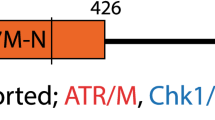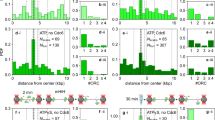Abstract
Eukaryotic replication origins are 'licensed' for replication early in the cell cycle by loading Mcm(2–7) proteins. As chromatin replicates, Mcm(2–7) are removed, thus preventing the origin from firing again. Here we report the purification of the RLF-B component of the licensing system and show that it corresponds to Cdt1. RLF-B/Cdt1 was inhibited by geminin, a protein that is degraded during late mitosis. Immunodepletion of geminin from metaphase extracts allowed them to assemble licensed replication origins. Inhibition of CDKs in metaphase stimulated origin assembly only after the depletion of geminin. These experiments suggest that geminin-mediated inhibition of RLF-B/Cdt1 is essential for repressing origin assembly late in the cell cycle of higher eukaryotes.
This is a preview of subscription content, access via your institution
Access options
Subscribe to this journal
Receive 12 print issues and online access
$209.00 per year
only $17.42 per issue
Buy this article
- Purchase on Springer Link
- Instant access to full article PDF
Prices may be subject to local taxes which are calculated during checkout








Similar content being viewed by others
References
Blow, J. J. & Laskey, R. A. A role for the nuclear envelope in controlling DNA replication within the cell cycle. Nature 332, 546–548 (1988).
Diffley, J. F. Once and only once upon a time: specifying and regulating origins of DNA replication in eukaryotic cells. Genes Dev. 10, 2819–2830 (1996).
Tada, S. & Blow, J. J. The replication licensing system. Biol. Chem. 379, 941–949 (1998).
Chong, J. P. J., Mahbubani, M. H., Khoo, C.-Y. & Blow, J. J. Purification of an Mcm-containing complex as a component of the DNA replication licensing system. Nature 375, 418–421 (1995).
Kubota, Y., Mimura, S., Nishimoto, S., Takisawa, H. & Nojima, H. Identification of the yeast MCM3-related protein as a component of Xenopus DNA Replication Licensing Factor. Cell 81, 601–609 (1995).
Madine, M. A., Khoo, C.-Y., Mills, A. D. & Laskey, R. A. MCM3 complex required for cell cycle regulation of DNA replication in vertebrate cells. Nature 375, 421–424 (1995).
Kubota, Y. et al. Licensing of DNA replication by a multi-protein complex of MCM/P1 proteins in Xenopus eggs. EMBO J. 16, 3320–3331 (1997).
Thömmes, P., Kubota, Y., Takisawa, H. & Blow, J. J. The RLF-M component of the replication licensing system forms complexes containing all six MCM/P1 polypeptides. EMBO J. 16, 3312–3319 (1997).
Prokhorova, T. A. & Blow, J. J. Sequential MCM/P1 subcomplex assembly is required to form a heterohexamer with replication licensing activity. J. Biol. Chem. 275, 2491–2498 (2000).
Diffley, J. F., Cocker, J. H., Dowell, S. J. & Rowley, A. Two steps in the assembly of complexes at yeast replication origins in vivo. Cell 78, 303–316 (1994).
Ishimi, Y. A DNA helicase activity is associated with an MCM4, -6, and -7 protein complex. J. Biol. Chem. 272, 24508–24513 (1997).
Kelman, Z., Lee, J. K. & Hurwitz, J. The single minichromosome maintenance protein of Methanobacterium thermoautotrophicum Delta H contains DNA helicase activity. Proc. Natl Acad. Sci. USA 96, 14783–14788 (1999).
Chong, J. P. J., Hayashi, M. K., Simon, M. N., Xu, R. M. & Stillman, B. A double-hexamer archaeal minichromosome maintenance protein is an ATP-dependent DNA helicase. Proc. Natl Acad. Sci. USA 97, 1530–1535 (2000).
Labib, K., Tercero, J. A. & Diffley, J. F. X. Uninterrupted MCM2–7 function required for DNA replication fork progression. Science 288, 1643–1647 (2000).
Shechter, D. F., Ying, C. Y. & Gautier, J. The intrinsic DNA helicase activity of Methanobacterium thermoautotrophicum Delta H minichromosome maintenance protein. J. Biol. Chem. 275, 15049–15059 (2000).
Cocker, J. H., Piatti, S., Santocanale, C., Nasmyth, K. & Diffley, J. F. An essential role for the Cdc6 protein in forming the pre-replicative complexes of budding yeast. Nature 379, 180–182 (1996).
Coleman, T. R., Carpenter, P. B. & Dunphy, W. G. The Xenopus Cdc6 protein is essential for the initiation of a single round of DNA replication in cell-free extracts. Cell 87, 53–63 (1996).
Rowles, A. et al. Interaction between the origin recognition complex and the replication licensing system in Xenopus. Cell 87, 287–296 (1996).
Romanowski, P., Madine, M. A., Rowles, A., Blow, J. J. & Laskey, R. A. The Xenopus origin recognition complex is essential for DNA replication and MCM binding to chromatin. Curr. Biol. 6, 1416–1425 (1996).
Maiorano, D., Moreau, J. & Mechali, M. XCDT1 is required for the assembly of pre-replicative complexes in Xenopus laevis. Nature 404, 622–625 (2000).
Nishitani, H., Lygerou, Z., Nishimoto, T. & Nurse, P. The Cdt1 protein is required to license DNA for replication in fission yeast. Nature 404, 625–628 (2000).
Whittaker, A. J., Royzman, I. & Orr-Weaver, T. L. Drosophila Double parked: a conserved, essential replication protein that colocalizes with the origin recognition complex and links DNA replication with mitosis and the down-regulation of S phase transcripts. Genes Dev. 14, 1765–1776 (2000).
Tada, S., Chong, J. P. J., Mahbubani, H. M. & Blow, J. J. The RLF-B component of the replication licensing system is distinct from Cdc6 and functions after Cdc6 binds to chromatin. Curr. Biol. 9, 211–214 (1999).
Gillespie, P. J. & Blow, J. J. Nucleoplasmin-mediated chromatin remodelling is required for Xenopus sperm nuclei to become licensed for DNA replication. Nucleic Acids Res. 28, 472–480 (2000).
Broek, D., Bartlett, R., Crawford, K. & Nurse, P. Involvement of p34cdc2 in establishing the dependency of S phase on mitosis. Nature 349, 388–393 (1991).
Hayles, J., Fisher, D., Woollard, A. & Nurse, P. Temporal order of S phase and mitosis in fission yeast is determined by the state of the p34cdc2–mitotic B cyclin complex. Cell 78, 813–822 (1994).
Correa-Bordes, J. & Nurse, P. p25rum1 orders S phase and mitosis by acting as an inhibitor of the p34cdc2 mitotic kinase. Cell 83, 1001–1009 (1995).
Dahmann, C., Diffley, J. & Nasmyth, K. S-phase-promoting cyclin-dependent kinases prevent re-replication by inhibiting the transition of replication origins to a pre-replicative state. Curr. Biol. 5, 1257–1269 (1995).
Piatti, S., Bohm, T., Cocker, J. H., Diffley, J. F. & Nasmyth, K. Activation of S-phase-promoting CDKs in late G1 defines a 'point of no return' after which Cdc6 synthesis cannot promote DNA replication in yeast. Genes Dev. 10, 1516–1531 (1996).
Noton, E. & Diffley, J. F. X. CDK inactivation is the only essential function of the APC/C and the mitotic exit network proteins for origin resetting during mitosis. Mol. Cell 5, 85–95 (2000).
Hennessy, K. M., Clark, C. D. & Botstein, D. Subcellular localization of yeast CDC46 varies with the cell cycle. Genes Dev. 4, 2252–2263 (1990).
Labib, K., Diffley, J. F. X. & Kearsey, S. E. G1-phase and B-type cyclins exclude the DNA-replication factor Mcm4 from the nucleus. Nature Cell Biol. 1, 415–422 (1999).
Nguyen, V. Q., Co, C., Irie, K. & Li, J. J. Clb/Cdc28 kinases promote nuclear export of the replication initiator proteins Mcm2–7. Curr. Biol. 10, 195–205 (2000).
Drury, L. S., Perkins, G. & Diffley, J. F. X. The Cdc4/34/53 pathway targets Cdc6p for proteolysis in budding yeast. EMBO J. 16, 5966–5976 (1997).
Elsasser, S., Chi, Y., Yang, P. & Campbell, J. L. Phosphorylation controls timing of Cdc6p destruction: A biochemical analysis. Mol. Biol. Cell 10, 3263–3277 (1999).
Saha, P. et al. Human CDC6/Cdc18 associates with Orc1 and cyclin-cdk and is selectively eliminated from the nucleus at the onset of S phase. Mol. Cell. Biol. 18, 2758–2767 (1998).
Jiang, W., Wells, N. J. & Hunter, T. Multistep regulation of DNA replication by Cdk phosphorylation of HsCdc6. Proc. Natl Acad. Sci. USA 96, 6193–6198 (1999).
Petersen, B. O., Lukas, J., Sorensen, C. S., Bartek, J. & Helin, K. Phosphorylation of mammalian CDC6 by Cyclin A/CDK2 regulates its subcellular localization. EMBO J. 18, 396–410 (1999).
Sun, W. et al. The replication capacity of intact mammalian nuclei in Xenopus egg extracts declines with quiescence, but the residual DNA synthesis is independent of Xenopus MCM proteins. J. Cell Sci. 113, 683–695 (2000).
Mahbubani, H. M., Chong, J. P., Chevalier, S., Thömmes, P. & Blow, J. J. Cell cycle regulation of the replication licensing system: involvement of a Cdk-dependent inhibitor. J. Cell Biol. 136, 125–135 (1997).
McGarry, T. J. & Kirschner, M. W. Geminin, an inhibitor of DNA replication, is degraded during mitosis. Cell 93, 1043–1053 (1998).
Blow, J. J. Preventing re-replication of DNA in a single cell cycle: evidence for a replication licensing factor. J. Cell Biol. 122, 993–1002 (1993).
Kubota, Y. & Takisawa, H. Determination of initiation of DNA replication before and after nuclear formation in Xenopus egg cell free extracts. J. Cell Biol. 123, 1321–1331 (1993).
Hua, X. H. & Newport, J. Identification of a preinitiation step in DNA replication that is independent of origin recognition complex and cdc6, but dependent on cdk2. J. Cell Biol. 140, 271–281 (1998).
Rowles, A., Tada, S. & Blow, J. J. Changes in association of the Xenopus origin recognition complex with chromatin on licensing of replication origins. J. Cell Sci. 112, 2011–2018 (1999).
Vesely, J. et al. Inhibition of cyclin-dependent kinases by purine analogs. Eur. J. Biochem. 224, 771–786 (1994).
Meijer, L. et al. Biochemical and cellular effects of roscovitine, a potent and selective inhibitor of the cyclin-dependent kinases cdc2, cdk2 and cdk5. Eur. J. Biochem. 243, 527–536 (1997).
Luca, F. C. & Ruderman, J. V. Control of programmed cyclin destruction in a cell-free system. J. Cell Biol. 109, 1895–1909 (1989).
Hua, X. H., Yan, H. & Newport, J. A role for Cdk2 kinase in negatively regulating DNA replication during S phase of the cell cycle. J. Cell Biol. 137, 183–192 (1997).
Chong, J. P., Thömmes, P., Rowles, A., Mahbubani, H. M. & Blow, J. J. Characterization of the Xenopus replication licensing system. Methods Enzymol. 283, 549–564 (1997).
Acknowledgements
We thank Jason Swedlow, Tom Owen-Hughes, Neil Perkins, Margret Michalski and members of the laboratory for comments on the manuscript. This work was supported by the Cancer Research Campaign (grant SP2385/1001) and by a Uehara Fellowship to S.T.
Author information
Authors and Affiliations
Corresponding author
Rights and permissions
About this article
Cite this article
Tada, S., Li, A., Maiorano, D. et al. Repression of origin assembly in metaphase depends on inhibition of RLF-B/Cdt1 by geminin. Nat Cell Biol 3, 107–113 (2001). https://doi.org/10.1038/35055000
Received:
Revised:
Accepted:
Published:
Issue Date:
DOI: https://doi.org/10.1038/35055000
This article is cited by
-
Unscheduled DNA replication in G1 causes genome instability and damage signatures indicative of replication collisions
Nature Communications (2022)
-
SPOP mutation induces replication over-firing by impairing Geminin ubiquitination and triggers replication catastrophe upon ATR inhibition
Nature Communications (2021)
-
Epigenetic homogeneity in histone methylation underlies sperm programming for embryonic transcription
Nature Communications (2020)
-
Controlling centriole numbers: Geminin family members as master regulators of centriole amplification and multiciliogenesis
Chromosoma (2018)
-
A journey through the microscopic ages of DNA replication
Protoplasma (2017)



